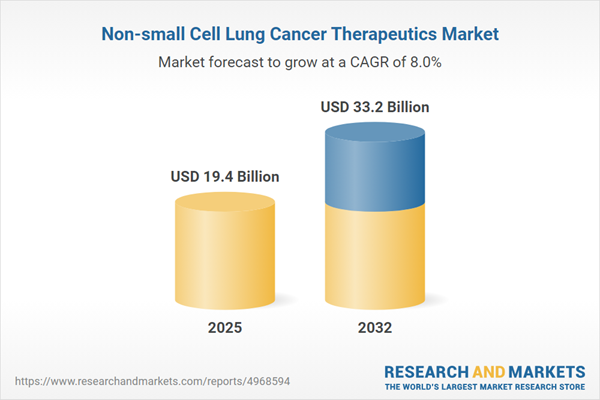Speak directly to the analyst to clarify any post sales queries you may have.
The non-small cell lung cancer therapeutics market is evolving rapidly, driven by advancements in treatment modalities, digital health integration, and global regulatory changes. Senior leaders require a clear understanding of the sector’s transformation to navigate investment, competitive strategy, and risk mitigation effectively.
Market Snapshot: Non-Small Cell Lung Cancer Therapeutics Market Growth
The Non-small Cell Lung Cancer Therapeutics Market grew from USD 17.94 billion in 2024 to USD 19.40 billion in 2025. With a projected CAGR of 7.99%, the market is expected to reach USD 33.20 billion by 2032. This significant expansion is underpinned by a surge in innovative therapies and enhanced patient stratification, fuelling demand for targeted and immune-driven treatments worldwide.
Scope & Segmentation
- Treatment Types: Chemotherapy, immunotherapy (CTLA-4 inhibitors, PD-1 inhibitors, PD-L1 inhibitors), and targeted therapy (ALK, BRAF, EGFR, ROS1 inhibitors, including differentiation by generation among EGFR inhibitors)
- Lines of Therapy: First, second, and third or later line treatments including chemotherapy, combination therapy, immunotherapy, and targeted therapy at each stage
- Biomarker Expression: ALK rearrangement, EGFR mutation, high PD-L1 expression, KRAS mutation
- Distribution Channels: Hospital pharmacy, online pharmacy, retail pharmacy
- Regional Markets: Americas (United States, Canada, Mexico, Brazil, Argentina, Chile, Colombia, Peru), Europe, Middle East & Africa (including United Kingdom, Germany, France, Russia, Italy, Spain, Netherlands, Sweden, Poland, Switzerland, United Arab Emirates, Saudi Arabia, Qatar, Turkey, Israel, South Africa, Nigeria, Egypt, Kenya), and Asia-Pacific (China, India, Japan, Australia, South Korea, Indonesia, Thailand, Malaysia, Singapore, Taiwan)
- Key Companies Analyzed: Amgen Inc., AstraZeneca PLC, BeiGene Ltd., Bristol-Myers Squibb Company, F. Hoffmann-La Roche Ltd., Merck & Co., Novartis AG, Pfizer Inc., Regeneron Pharmaceuticals, Takeda Pharmaceutical Company Limited
Key Takeaways
- The market is shaped by an increased shift toward immunotherapy and precision oncology, responding to unmet clinical needs in distinct patient subpopulations.
- Emerging technologies such as real-time molecular monitoring and artificial intelligence are streamlining biomarker discovery and patient stratification.
- Strategic alliances and licensing agreements between biotech innovators and established pharmaceutical leaders are accelerating drug development, with companion diagnostics gaining prominence.
- Distribution channel evolution—particularly the growth of hospital and online pharmacies—is influencing accessibility and patient engagement strategies.
- Regional disparities, notably in reimbursement and infrastructure, prompt stakeholders to adopt locally tailored market entry and commercialization tactics.
- Active engagement with regulatory bodies and adaptability in pricing models help address supply chain pressures and dynamic policy environments.
Tariff Impact: Navigating United States Policy Shifts
Recent United States tariff regulations have introduced new complexities, particularly for manufacturers reliant on biologics and imported raw materials. These changes are prompting companies to diversify sourcing strategies, reevaluate manufacturing locations, and leverage trade benefits such as free-trade zones. Healthcare providers and payers are also adapting, intensifying focus on value-based contracts and total cost management to maintain patient access and quality outcomes.
Methodology & Data Sources
This report utilizes a multi-stage methodology including primary interviews with oncologists, payers, patient advocates, and executives, validated through secondary research from clinical journals, regulatory data, and proprietary analytics. Scenario planning and expert panel reviews ensure findings are reliable and industry-relevant.
Why This Report Matters
- Enables leadership teams to identify high-growth market segments and emerging technology opportunities within the non-small cell lung cancer therapeutics field.
- Guides evidence-based strategy, from risk planning for regulatory shifts like new tariffs to investment in biomarker-driven innovations.
- Supports actionable intelligence for regional expansion, pricing adaptation, and alliance building.
Conclusion
The future of non-small cell lung cancer therapeutics will depend on robust innovation, adaptable supply chains, and patient-centric strategies. This report equips decision-makers to confidently advance strategic priorities and respond proactively to evolving global market dynamics.
Additional Product Information:
- Purchase of this report includes 1 year online access with quarterly updates.
- This report can be updated on request. Please contact our Customer Experience team using the Ask a Question widget on our website.
Table of Contents
3. Executive Summary
4. Market Overview
7. Cumulative Impact of Artificial Intelligence 2025
Companies Mentioned
The companies profiled in this Non-small Cell Lung Cancer Therapeutics market report include:- Amgen Inc.
- AstraZeneca PLC
- BeiGene, Ltd.
- Bristol-Myers Squibb Company
- F. Hoffmann-La Roche Ltd.
- Merck & Co., Inc.
- Novartis AG
- Pfizer Inc.
- Regeneron Pharmaceuticals, Inc.
- Takeda Pharmaceutical Company Limited
Table Information
| Report Attribute | Details |
|---|---|
| No. of Pages | 195 |
| Published | November 2025 |
| Forecast Period | 2025 - 2032 |
| Estimated Market Value ( USD | $ 19.4 Billion |
| Forecasted Market Value ( USD | $ 33.2 Billion |
| Compound Annual Growth Rate | 7.9% |
| Regions Covered | Global |
| No. of Companies Mentioned | 11 |









